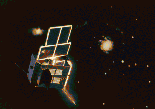|
|
EXOSAT Transmission Grating Spectrometer
A schematic view of the LE telescope with the TGS

Data products
The available products for the Transmission Grating Spectromenter (TGS:
TGS1 and TGS2) are spectra,response matrices and lightcurves.
Each TGS was inserted behind each telescope and the dispersed spectrum imaged
by the CMA.
Lightcurves, spectra and response matrices were originally created, in binary
format, at the EXOSAT Observatory during the post operational phase.
HEASARC converted all EXOSAT TGS products in FITS format.
Because the failure of the CMA2 detector and the failure of the mechanism
for raising the grating associated with the TGS1, only 24 sources
in total for both TGS’s were observed, but only 19 gave a useful spectrum.
At HEASARC the products, in FITS format, are available from
EXOSAT tgs FTP
area on the heasarc.gsfc.nasa.gov machine.
- Lightcurves :
For each source there is a background subtracted lightcurve (per filter),
nominally taken as a 16 by 16 pixel box centered on the zero order.
The EXOSAT TGS lightcurves in FITS format make use of the FITS binary table extension
(BINTABLE). The specific FITS layout of the data is described
in the Legacy 3, 32. The total number of EXOSAT TGS lightcurves in FITS format is
36. HEASARC generated also GIF files (available from the
EXOSAT tgs FTP area) for each lightcurve available.
- Spectra and Response Matrices
Within an observation for both TGS's, the 2048 and 1024 source spectra
were accumulated for each filter or if the pointing position changed.
The source spectra are not background subtracted. Background spectra
were instead estimated from an image of a long blank-field exposure,
using the same source region extraction, and renormalized to the source image.
The 2048 channel spectra were extracted from the CMA's (CMA1 and CMA2)
images using a mask of 40 to 50 pixels width (Y-axis) and
integrating perpendicular to the dispertion direction (X-axis).
The 1024 channel spectra consisted of the positive and negative orders
added together. For each of the 2048 (or 1024) spectrum, a response is
also available. In addition, when possible, simultaneous GSPC and/or ME
spectra covering the same exact amount of time were accumulated.
The EXOSAT TGS spectra and response matrices (as well as the
associated GSPC and/or ME spectra) in FITS format make use of the FITS binary
table extension (BINTABLE).
The specific FITS layout for spectra and response
matrices are described in the Legacy Journal 2, 65 and Legacy Journal 2, 51 respectivaly.
HEASARC generated also GIF files (available from the
EXOSAT tgs FTP area) which show the 1024 channel spectrum convolved with
the response matrix.
A CDROM (vol2)
containing all the lightcurves, spectra (only the 1024 channel) and response matrices
in FITS and GIF format is available and was first distributed at the
188th AAS Meeting (9-13 June 1996 Madison, Wisconsin).
IMPORTANT: The TGS response matrices were remade in August 1997.
The previous version of the FITS file (in the archive and on the CD)
were incorret.
Click here for further information
Software
- Products:
XSPEC and XRONOS software packages are useful for analysis of the
FITS spectra and lightcurves respectivaly. The
FTOOL package provides also a number of programs to manipulate
the FITS file. The GIF files can be viewed on UNIX and VMS with the package xv, under
DOS with ColorView and under MacOS with Giffer.
[EXOSAT Home]
[About EXOSAT]
[Archive]
[Software]
[Gallery]
[Publications]
Page authors: Lorella Angelini Jesse Allen
HEASARC Home |
Observatories |
Archive |
Calibration |
Software |
Tools |
Students/Teachers/Public
Last modified: Tuesday, 21-Apr-2020 17:07:20 EDT
|


